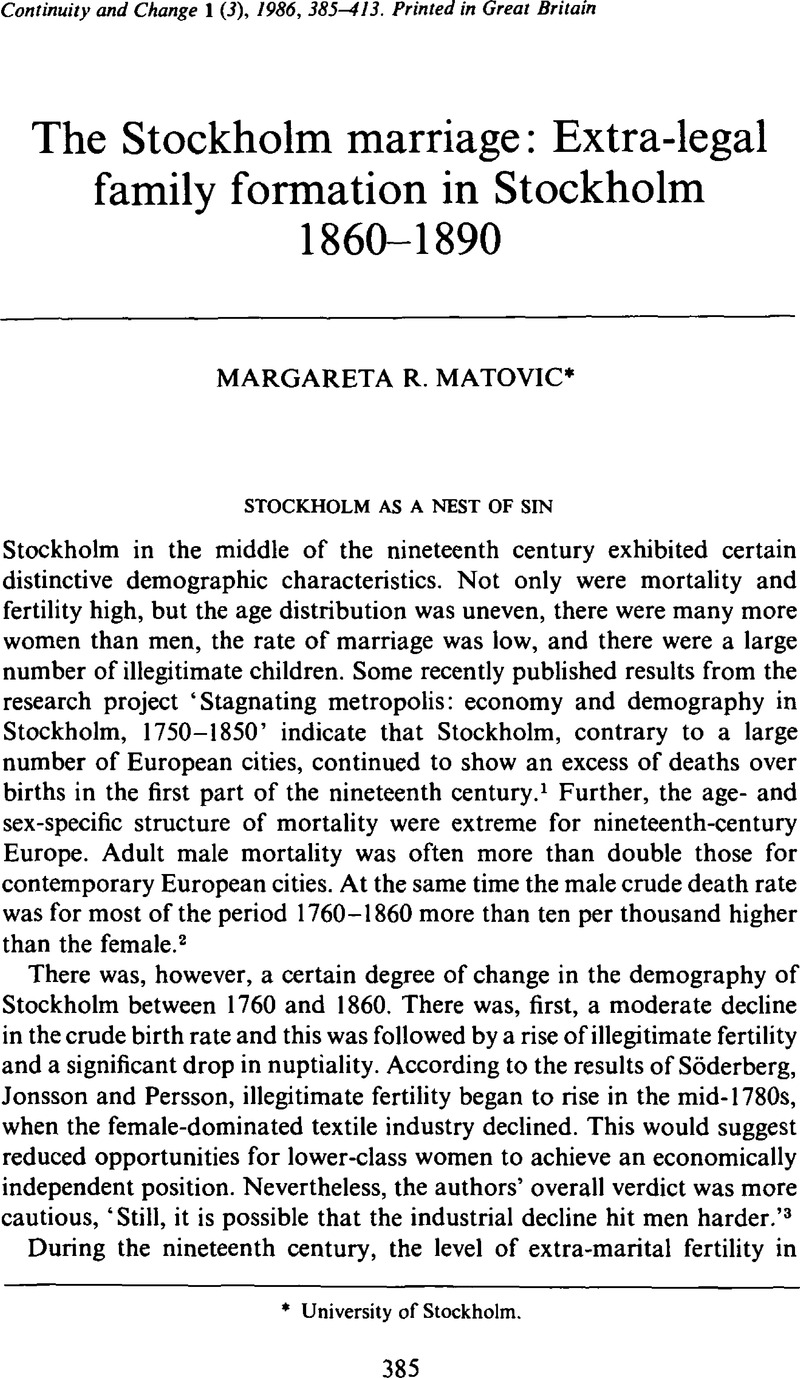Article contents
The Stockholm marriage: Extra-legal family formation in Stockholm 1860–1890
Published online by Cambridge University Press: 11 November 2008
Abstract

- Type
- Articles
- Information
- Copyright
- Copyright © Cambridge University Press 1986
References
ENDNOTES
1 Soderberg, J., Jonsson, U. and Persson, C., Stagnating metropolis: Economy and demo graphy in Stockholm 1750–1850, Research Report 4, 12 1984, Department of Economic History, University of Stockholm, 18.Google Scholar
2 Jonsson, U., Mortality patterns in eighteenth- and nineteenth-century Stockholm in a European perspective, Research Report 2, 06 1984, Department of Economic History, University of Stockholm, 6.Google Scholar
3 Söderberg, Jonsson and Persson, Stagnating metropolis, 10.
4 Ibid., 9.
5 Ibid., 11.
6 Befolkningsstatistik for 1861, VII–IX. Bidrag till Sveriges officiella statistik, serie A, Befolkningsstatistik 1850–1890, Stockholm.
7 Frykman, J., Horan i bondesamhället (Lund, 1977), 206.Google Scholar
8 Hansson, S., Skratidens gesäller (Stockholm, 1930), 130–33, 148.Google Scholar
9 Befolkningsstatistik för 1851–1856, 46 (first section). Bidrag till Sveriges officiella statistik, serie A, Befolkningsstatistik 1850–1890 (Stockholm).
10 Carlsson, S., Fröknar, Mamseller, Jungfrur och Pigor 28–9. Stadia Historica Upsaliensis, 90 (Uppsala, 1977).Google Scholar
11 Ibid.
12 Shorter, E., ‘Female emancipation, birth control and fertility in European history’, American Historical Review, 78 (1973), 605–40.CrossRefGoogle ScholarPubMed
13 Frykman, J., Horan i bondesamhället, 189.Google Scholar
14 Söderberg, Jonsson and Persson, Stagnating metropolis, 10.
15 Ibid., 11.
16 Ibid., 10.
17 Ibid., 18.
18 Matovic, M. R., Stockholmsaktenskap (Stockholm, 1984), 29–46.Google Scholar
19 Knodel, J. and Hochstadt, S., ‘Urban and rural illegitimacy in imperial Germany’, in Laslett, P. et al. , eds, Bastardy and its comparative history (London, 1980), 311–12.Google Scholar
20 Matovic, , Stockholmsäktenskap, 108–39.Google Scholar
21 Soderberg, J., Poverty and social structure in Stockholm in 1850, Research Report 1, November 1982, Department of Economic History, University of Stockholm, 4–6.Google Scholar
22 Söderberg, Jonsson and Persson, Stagnating Metropolis, 9.Google Scholar
23 Matovic, M. R., Stockholmsäktenskap, 117–19, 288–9.Google Scholar
24 Ibid., 120–2, 136–7.
25 Ibid., 37–9.
26 Kalvemark, A. S., Illegitimacy and marriage in Stockholm in the nineteenth century, in Laslett, et al. , eds. Bastardy and its comparative history, 330.Google Scholar
27 Matovic, M. R., Stockholmsäktenskap, 36.Google Scholar
28 Kalvemark, A. S., Illegitimacy and marriage, 335.Google Scholar
29 Matovic, M. R., ‘Illegitimacy and marriage in Stockholm in the nineteenth century’, in Laslett, et al. , eds, Bastardy and its comparative history, 340–2.Google Scholar
30 Ibid., 342.
31 Qvist, G., Kvinnofrägan i Sverige (Göteborg, 1960), 161, 225.Google Scholar
32 Strindberg, A., The red room (London, 1913), 204.Google Scholar
33 Almqvist, C. J. L., Sara Videbeck (New York, 1972), 180.Google Scholar
34 Ibid., 115–16.
35 Matovic, Stockholmsäktensap, 309–11 shows that 25 per cent of the daughters of large landowners announcing the banns of matrimony during the period 1860–9 were without children but sharing a common address with their partner. Considerably fewer of the daughters of higher administrators and major entrepreneurs were in this position (11 per cent and 7 per cent respectively).
36 During the 1850s and 1860s, such hidden forms of extra-legal family formation were particularly associated with the middle and upper classes. See Agardh, C. A., Forsok tillen Statsekonomisk Slatistik öfver Sverige, 3, 2 (Stockholm, 1857), 200.Google Scholar
37 Private letters, Y. Mathson's archive, 1984; church records from St Nicholaus parish, 1858, (1860).Google Scholar
38 Matovic, Stockholmsäktenskap, 246–50.
39 See, eg Etienne, van de Walle, ‘Illegitimacy in France during the nineteenth century’, in Laslett, et al. , eds, Bastardy and its comparative history, 264 ffGoogle Scholar. and Thomson, E. P., The making of the English working class (London, 1963).Google Scholar
40 Shorter, E., ‘Illegitimacy, sexual revolution and social change in Europe’, Journal of Interdisciplinary History 2 (1971)CrossRefGoogle Scholar; ‘Capitalism, culture and sexuality: some competing models’, Social Science Quarterly (1972) and ‘Female Emancipation’.Google Scholar
41 Smout, C., ‘Aspects of sexual behaviour in nineteenth-century Scotland’, in Laslett, et al. , eds, Bastardy and its comparative history, 203, 215.Google Scholar
42 O'Lewis, , La Vida (London, 1968), 48–52.Google Scholar
43 Söderberg, Jonsson, and Persson, , Stagnating metropolis, 18.Google Scholar
- 5
- Cited by


